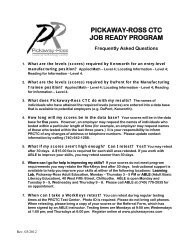Commons
Conceptual Physics - elearning-phys
Conceptual Physics - elearning-phys
- No tags were found...
You also want an ePaper? Increase the reach of your titles
YUMPU automatically turns print PDFs into web optimized ePapers that Google loves.
l / Galileo Galilei was the first physicist to state the principle of inertia (ina somewhat different formulation than the one given here). His contradictionof Aristotle had serious consequences. He was interrogated by theChurch authorities and convicted of teaching that the earth went aroundthe sun as a matter of fact and not, as he had promised previously, as amere mathematical hypothesis. He was placed under permanent housearrest, and forbidden to write about or teach his theories. Immediately afterbeing forced to recant his claim that the earth revolved around the sun,the old man is said to have muttered defiantly “and yet it does move.”The principle of inertia says, roughly, that all frames of referenceare equally valid:The principle of inertiaThe results of experiments don’t depend on the straight-line,constant-speed motion of the apparatus.Speaking slightly more precisely, the principle of inertia says thatif frame B moves at constant speed, in a straight line, relative toframe A, then frame B is just as valid as frame A, and in fact anobserver in frame B will consider B to be at rest, and A to be moving.The laws of physics will be valid in both frames. The necessity forthe more precise formulation becomes evident if you think aboutexamples in which the motion changes its speed or direction. Forinstance, if you’re in a car that’s accelerating from rest, you feelyourself being pressed back into your seat. That’s very different fromthe experience of being in a car cruising at constant speed, whichproduces no physical sensation at all. A more extreme example ofthis is shown in figure m on page 18.A frame of reference moving at constant speed in a straight lineis known as an inertial frame of reference. A frame that changesits speed or direction of motion is called noninertial. The principleof inertia applies only to inertial frames. The frame of referencedefined by an accelerating car is noninertial, but the one defined bya car cruising at constant speed in a straight line is inertial.Foucault’s pendulum example 2Earlier, I spoke as if a frame of reference attached to the surfaceof the rotating earth was just as good as any other frame of reference.Now, with the more exact formulation of the principle ofinertia, we can see that that isn’t quite true. A point on the earth’ssurface moves in a circle, whereas the principle of inertia refersonly to motion in a straight line. However, the curve of the motionis so gentle that under ordinary conditions we don’t noticethat the local dirt’s frame of reference isn’t quite inertial. The firstdemonstration of the noninertial nature of the earth-fixed frame ofreference was by Léon Foucault using a very massive pendulumn / Foucault demonstrateshis pendulum to an audience at alecture in 1851.Section 1.4 Conservation of Energy 17



